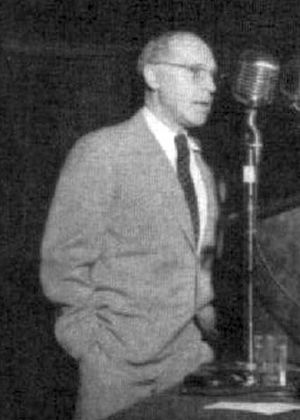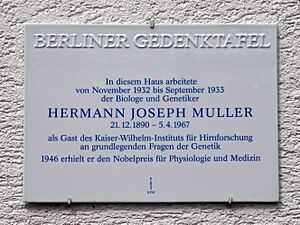H. J. Muller facts for kids
Quick facts for kids
Hermann Joseph Muller
|
|
|---|---|

The Journal of Science Fiction #4, 1953
|
|
| Born | December 21, 1890 |
| Died | April 5, 1967 (aged 76) |
| Occupation | Geneticist |
| Known for | Nobel Prize in Physiology or Medicine in 1946 |
Hermann Joseph Muller, known to many as H. J. Muller, was an American scientist. He was born on December 21, 1890, and passed away on April 5, 1967. He was a geneticist, a teacher, and a winner of the Nobel Prize.
Muller is famous for his research on how radiation affects living things and their genes. He also had strong political opinions. He often warned people about the long-term dangers of radioactive fallout from nuclear explosions. This fallout is the harmful dust that spreads after a nuclear blast.
Contents
Muller's Amazing Life Journey
Hermann Muller's life was full of interesting moves and discoveries. He was born in New York City. He earned his PhD at CalTech. There, he worked in a lab that studied Drosophila, which are tiny fruit flies. This lab was led by a famous scientist named Thomas Hunt Morgan.
Working and Moving Around
After CalTech, Muller worked at Rice University. Then, he spent twelve years at the University of Texas. In 1932, he moved to Berlin, a big city in Germany. From there, he went to Leningrad (now called St. Petersburg) in Russia. Later, he moved to Moscow, also in Russia.
In each of these places, Muller set up a new genetics lab. He also taught science to students.
Challenges in Science
During his time in Russia, a scientist named Lysenko became very powerful. Lysenko did not believe in true genetics. Because of this, real genetics scientists, like Muller, faced problems. The leader of Russia at the time, Stalin, supported Lysenko.
Returning Home
Because of these difficulties, Muller moved again. He went to Edinburgh in Scotland. He even brought 250 different types of Drosophila flies with him! Finally, in 1940, he returned to the United States. He became an advisor for the Manhattan Project, which was a secret project during World War II. Later, he became a Professor of Zoology at Indiana University.
Nobel Prize and Discoveries
H. J. Muller won the Nobel Prize in Physiology or Medicine in 1946. He received this award for his important discovery. He found that changes in genes, called mutations, can be caused by X-rays.
Impact of His Work
By the time he won the Nobel Prize, scientists were very interested in similar effects. They wanted to know how gamma rays from nuclear testing could also cause mutations. Muller's work was very important for understanding how radiation affects living things.
Muller's Other Beliefs
Muller strongly believed in several ideas. These included eugenics, socialism, and atheism. While these ideas were not always popular, his biggest contribution was to the field of genetics.
One respected source said this about Muller: "Muller's contributions were very important in the 1920s and 1930s. He created many genetic tools. These tools made Drosophila flies super important for studying genes. When you read Muller's articles from those years, you can see his amazing genius. He was brilliant at analyzing and planning his discoveries and experiments."
Images for kids
-
Muller's house in Bloomington, Indiana
See also
 In Spanish: Hermann Joseph Muller para niños
In Spanish: Hermann Joseph Muller para niños



